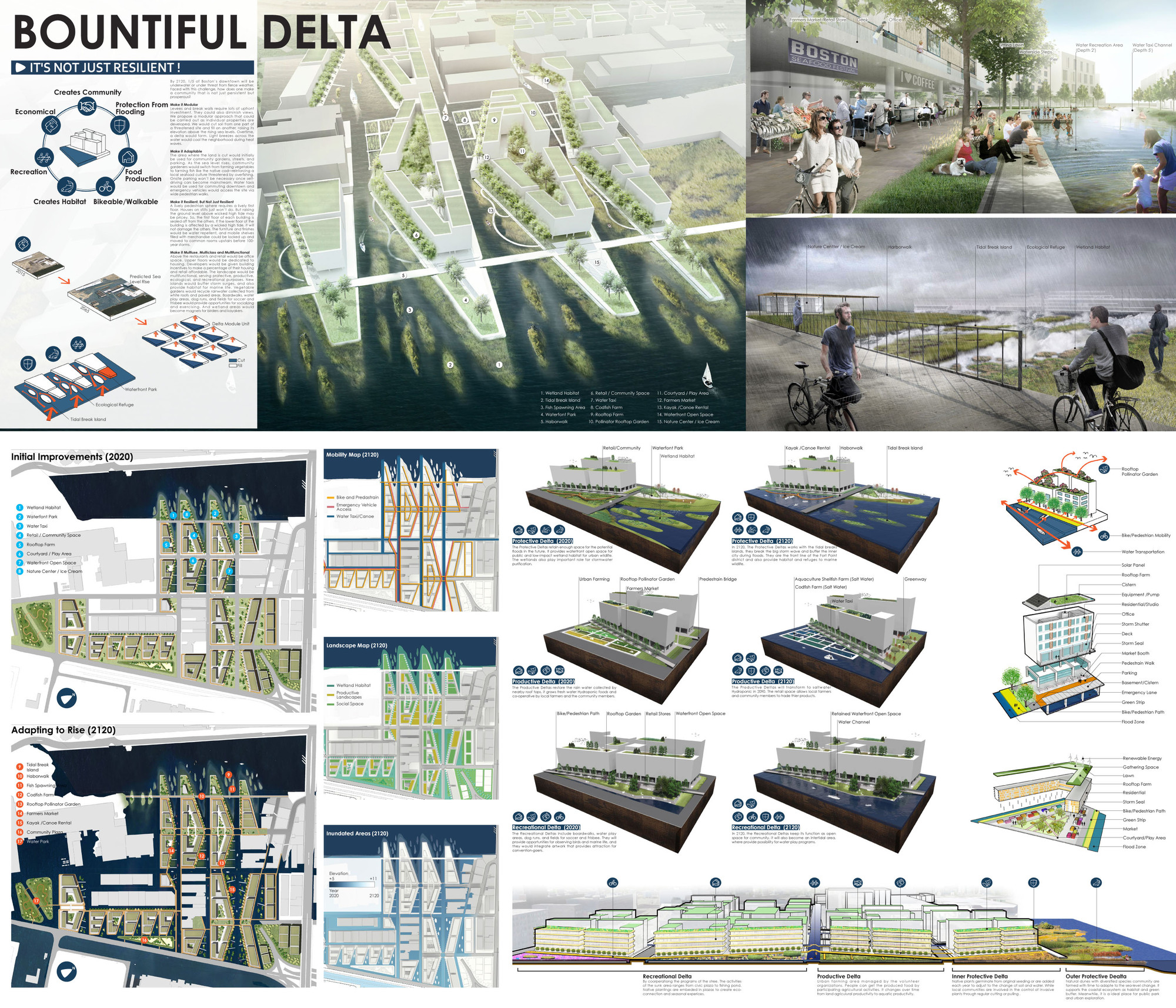
Nine finalists have emerged in the Boston Living with Water design competition. The ongoing initiative challenges competitors to address shifting climate conditions and sea level rise at one of three Boston sites anticipated to be affected by 2100. Although the 50 participating teams took different approaches to designing for climate change, all the submissions treated the rising sea level as a positive design force in Boston's built environment.
Check out the finalists, after the break.
The finalists were announced at a reception hosted by BSA Space, which included a discussion of the projects by the competition's jury. Three finalists were selected per site that best accounted for its unique climate conditions, minimized flood damage, and provided a resilient, sustainable solution. The designs will be further explored and resubmitted in May, and one will be selected as the $20,000 grand prize recipient in June.
The finalists selected in the building category are:
“The Prince Building Piers” led by Stephanie Goldberg AIA and Mark Reed AIA – Rather than trying to prevent seawater from entering the city, this proposal welcomes the water and surrenders the outer streetscapes to a new urban seashore that is a focus of recreation, ecological reclamation, and new cultural experiences.

“Water FUN(d)” led by ARC/Architectural Resources Cambridge – Dubbed the Future Underwater Neighborhood district, or FUN(d), this proposal establishes a goal of creating a new urban area that skillfully interacts with an influx of water on an on-going basis. The team suggests that this plan could be accomplished, at least in part, by drawing on revenue from Boston’s tourism economy.
.jpg?1426109812)
“No Building is an Island” led by Harvard Graduate School of Design – One of the most creative aspects of this proposal is the Resilience Report Card, a simple, user-friendly method that would indicates a building’s vulnerability and allow the city to map risk and target investments.

The finalists selected in the neighborhood category are:
“Bountiful Delta” led by University of Washington – Guided by the notion that resilience alone is not good enough, this proposal envisions waterfront neighborhoods that “are not just persistent but prosperous.” The strategy calls for modular infrastructure, adaptable land (think of a community garden that could be transformed for fish farming), a lively and water-resilient pedestrian streetscape, and community spaces, restaurants, and retail establishments to provide a genuine neighborhood feel.

“Resilient Linkages” led by NBBJ – This proposal attempts to balance the immediate pressure for development in Fort Point with the long-term understanding that the area will be prone to regular flooding in the future. The plan would establish a new, elevated street grid and require developers to integrate supportive infrastructure for sea level rise into their projects, which could then be linked to form fully-functional, neighborhood-scale infrastructure.

“Model Urban Waterfront District” led by Architerra Inc. – This proposal would raise the entire base and infrastructure of the 100-acre neighborhood by approximately twelve feet, matching the raised elevation of historic Summer Street and creating a resilient development area to serve as a model urban waterfront district for the 21st and 22ndcenturies.

The finalists in the infrastructure category are:
“The Hydrokinetic Canal” led by Paul Lukez Architecture – This proposal for transforming Morrissey Boulevard and Harbor Point over the next 100 years draws inspiration from the topographic and land-use patterns of 17th century Boston. A new system of waterways would be created to increase Columbia Point’s resilience to climate change, generate sustainable energy, and provide an expanded, improved public realm. A new Hydrokinetic Canal is this urban plan’s centerpiece.

“The Omega Chain” led by Howard & Cavaluzzi Architects Int. LLC, Beijing Office – The Omega Chain would be a resilient network system around the Columbia Point peninsula that connects disparate areas with holistic mechanisms that transcend simple solutions and elevate quality of life for residents. It contemplates gradually converting the existing Morrissey Boulevard into a landscaped park and constructing a new elevated and curved roadway adjacent to the park to calm fast-moving traffic.

“Total Resilient Approach” led by Thetis S.p.A. – This proposal considers the transportation infrastructure as a flexible element aimed at performing a wide range of resilient functions. Raising Morrissey Boulevard and improving its connections to the adjacent neighborhood present an opportunity to redevelop Columbia Point through an overall strategy based on habitat restoration and sustainable urban landscaping.

The Boston Living with Water competition was organized by the City of Boston, The Boston Harbor Association, the Boston Redevelopment Authority, and the Boston Society of Architects. For more information on the finalists and to view the other entries, visit www.bostonlivingwithwater.org
Project descriptions via Boston Society of Architects




.jpg?1426109812)




.jpg?1426109812)





